 |
 |
This is the fourth in a series of articles about using various methods of protecting a wooden table from the heat emitted by a kamado-style ceramic cooker.
- In our first article, "How To Avoid A House Fire Or Serious Accident By Using The Proper Base For Your Big Green Egg", one of our readers explains why you need to protect your table, and details his particular solution for doing so.
- In our second article, "What Material Should You Use Beneath Your Kamado-Style Cooker On A Wood Table?" we test a variety of materials such as concrete pavers, two types of firebrick, vermiculite and sheets of calcium silicate to see how well they insulated a wood table from a hot cooker.
- In our third article, "How Well Does A BGE Table Nest Protect A Wooden Table?" we compare using a Big Green Egg Table Nest against using vermiculite bricks for use in protecting your wood table from heat radiating from a ceramic cooker.
- In this fourth article we look at using two more materials that you often see people suggest using beneath their cookers, ceramic tile and bluestone (or slate).
Introduction
If you wonder why you need to protect your
table, you need look no further than these photos:
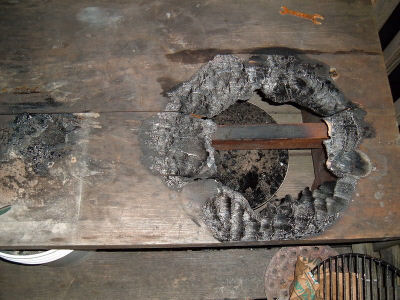
Damage to a wooden table when using a |

A wooden table that got charred despite |
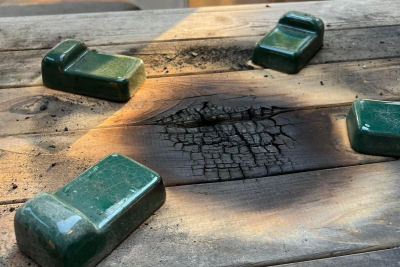
Damage to a wooden table when using the |
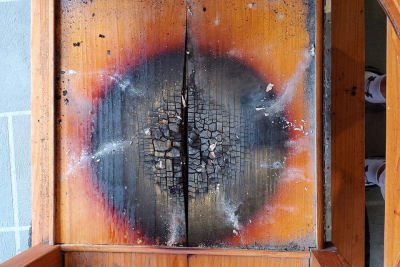 Another wooden table almost set on fire. |
So, what's the answer? Well, we have been looking at how effective various materials are in protecting a wood table, including the Big Green Egg Table Nest, but now we will be looking at the effectiveness of using two more materials, ceramic tile and bluestone.
What Is Bluestone?
We'll assume that our readers know what ceramic tile is, but what exactly is bluestone? Well, there
are two types of bluestone that are quarried in the United States:
Thermal Conductivity
Thermal conductivity measures the ability of a material to transmit heat via conduction.
In the International System of Units (SI), thermal conductivity is measured in watts per
meter-kelvin (W/(m·K)). We won't bore you with the details, but suffice it to say that
the bigger the number when looking at thermal conductivity, the faster heat is conducted
through the material. Conversely, the smaller the number, the better the material insulates.
Here is a list of the materials tested previously, to which we have added ceramic tile and
bluestone (in orange):
| Material | Thermal Conductivity |
|---|---|
| Refractory (Heavy) Fire Brick | |
| Bluestone (limestone) | |
| Concrete (Paver) | |
| Ceramic Tile | |
| Kiln (Insulating) Fire Brick | |
| Vermiculite Brick | |
| Calcium Silicate | |
| Air (room temperature) |
As you can see, ceramic tile and bluestone have comparatively high thermal conductivities compared to some of the other materials we tested. If our experience with the other materials in the table is to be an indication, it seems ceramic tile and bluestone may not be the best materials to use. Let's run some tests and see how they perform.
How And What We Tested
When we tested various materials for their insulating value, we placed a chimney starter full of hot
charcoal directly on the material being tested. When we tested the Big Green Egg Table Nest against
vermiculite splits, we placed a pizza stone on top of the material and then the chimney starter on top
of the pizza stone. (The purpose of the pizza stone was to simulate the bottom of a ceramic cooker
between the heat of the fire and the substance below it.)
For this testing, we decided to do it both ways. Here are diagrams of the various
setups for the ceramic tile and the bluestone:

Figure 1. Test setups for the ceramic tile. The red dots indicate
the location of the thermocouples used to record temperatures.

Figure 2. Test setups for the bluestone. The red dots indicate
the location of the thermocouples used to record temperatures.
And here is a photo showing the actual setup in action during one of the tests:

Cermic Tile Results
This will be quick. With no pizza stone, the tiles exploded when the top tile reached
about 650°F. Yes, all three tiles shattered:
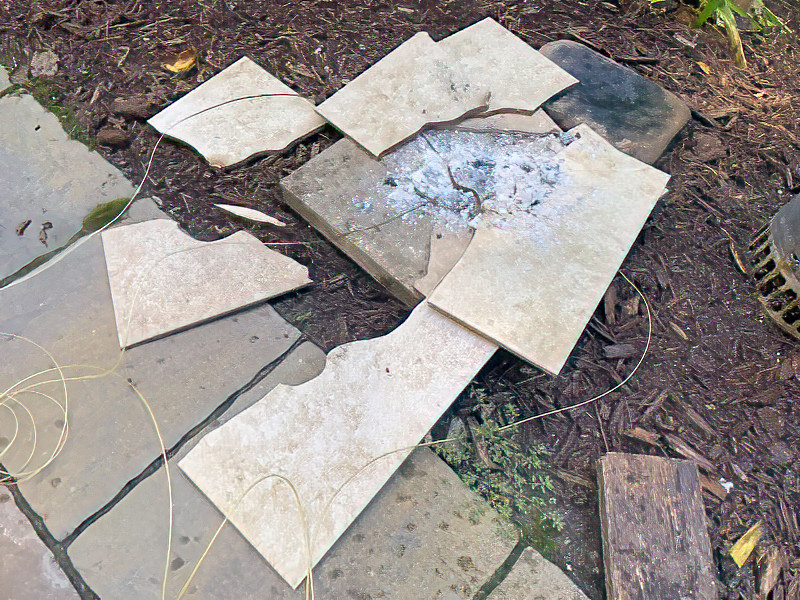
All three ceramic tiles shattered before they reached their maximum temperature.
When this occurred, the middle tile was at 500°F and the bottom tile was at 225°F. If we could find a 1" ceramic tile instead of using 3 thin flooring tiles, we suspect the tile would still shatter and would still rise to a temperature higher than most, if not all, of the materials have tested before.
What about the setup with the pizza stone? Off to Home Depot to buy three more tiles! And well, tiles still cracked but not so violently. The top tile cracked when it hit 650°F, but the tile beneath did not. We were able to push the top tile back together and keep going. The middle tile then cracked when it reached 650°F and again, we were able to push it back together and keep going. The bottom tile never reached 650°F and never cracked. At the end of the test, the temperature underneath the third tile was 339°F.
As you can see in the following table, ceramic tile (orange) does not produce a very good result compared to vermiculite and certainly compared to a table nest:
| Setup | Temperature |
|---|---|
| 3 Ceramic Tiles | |
| Vermiculite Splits | |
| Table Nest Unobstructed | |
| Table Nest Moderate Obstruction | |
| Table Nest Obstructed |
Needless to say, there is a very large risk of ceramic tiles cracking or even shattering in this type of application, so we would never recommend using ceramic tiles underneath a kamado-style ceramic cooker. This should be obvious based on photos found on the internet:
 Ceramic tile that has shattered from the heat of the cooker. |
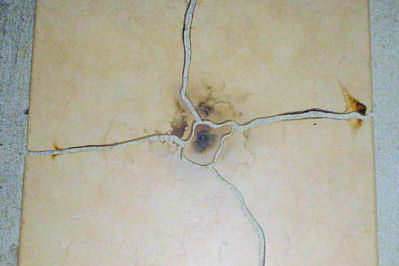 Another ceramic tile that has shattered from the heat of the cooker. |
So think of ceramic tile as a decorative feature for your table, not as a protective/insulating item. You can probably use it in conjunction with a Big Green Egg Table Nest, but you should make sure that you have plenty of air circulation lest the temperature rise to a point where the tile cracks.
Bluestone Results
So next we tried using bluestone in our tests. Nothing
shattered, but one stone did suffer a minor crack:

Fortunately, the crack was minor and the stone stayed in one piece so we could get some data to compare with all the other materials that we have tested previously.
In the configuration with a pizza stone on top of the bluestone, 1 inch of bluestone reached 364°F while 2 inches of bluestone reached 292°F. Compared to vermiculite and the Big Green Egg Table Nest, here is where bluestone fits into the pizza stone setup table:
| Setup | Temperature |
|---|---|
| 1 inch bluestone | |
| 3 Ceramic Tiles | |
| Vermiculite Splits | |
| 2 inch bluestone | |
| Table Nest Unobstructed | |
| Table Nest Moderate Obstruction | |
| Table Nest Obstructed |
So, using a 1 inch thick piece of bluestone is worse than the vermiculite bricks and far worse than the Big Green Egg Table Nest. Using a 2 inch thick piece of bluestone is slighltly better than the vermiculite bricks and again, nowhere near as effective as the Table Nest.
The other test we ran looked at using a variety of materials such as fire brick, vermiculite, calcium silicate, etc. In that test, we simply placed the chimney of burning charcoal directly on the material being tested. Fortunately, the bluestone didn't shatter so we could get temperature readings to compare with all those other materials. In this test the 1-inch bluestone reached 612°F while the 2-inch bluestone reached 456°F. Here's where the bluestone fit into the results of all materials:
| Material | Thermal Conductivity | Thickness of Material | Maximum Temperature (°F) |
|---|---|---|---|
| 1 inch bluestone | |||
| Refractory (Heavy) Fire Brick Split | |||
| 2 inch bluestone | |||
| Concrete Paver (1) | |||
| Kiln (Insulating) Fire Brick Split | |||
| Vermiculite Split (1) | |||
| Refractory (Heavy) Fire Brick | |||
| Calcium Silicate 1" | |||
| Kiln (Insulating) Fire Brick | |||
| Concrete Paver (2) | |||
| Vermiculite Split (2) | |||
| Calcium Silicate 2" |
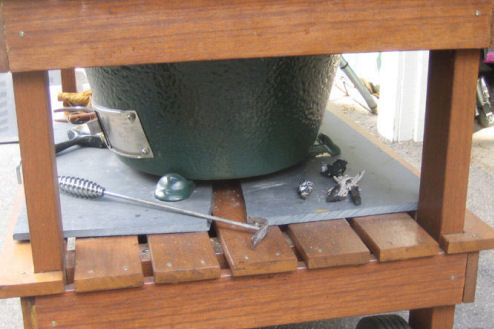 A sheet of bluestone that has shattered |
Conclusion
We think it should be clear that neither ceramic tile or bluestone are suitable for use protecting
a wood table from the heat of a ceramic cooker. Neither is a good insulator and both are prone to
cracking or shattering. Their dense, heavy composition allows them to absorb a lot of heat instead of
reflecting it and thus they initially seem to be good insulators when in reality they are just soaking
up the heat and storing it internally. When exposed to heat for extended periods of time they will
eventually become almost as hot as the heat source itself and then radiate this heat outward for a
long period of time. And this heat will damage your wood table.
If you like the appearance of either material and
would still like to use it, use it in conjunction with a Big Green Egg Table Nest.
Citations
1. Field and Laboratory Assessment of Different Concrete Paving Materials Thermal Behavior, Ivana Bariši´c, Ivanka Netinger Grubeša, Hrvoje Krsti´c and Dalibor Kubica, Sustainability 2022.2. Heat Retention Qualities Of Fire Brick, Steven Colbath, HomeSteady web site
3. Ibid, note 2.
4. Thermax Boards SF (1100°C) Technical Specification, SF750 vermiculite technical data.
5. Thermal conductivity of calcium silicate insulation..., The Engineering ToolBox web site.
6. "List of Thermal Conductivities", Wikipedia.
7. "R-Value for Natural Stone", Natural Stone Institute.
8. "Tile systems with enhanced thermal properties and methods of making and using same", Google Patents.
You can support this website by shopping at The Naked Whiz Website Store and Amazon.com
|